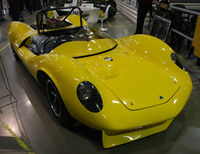Lotus 33
 | |
| Category | Formula One |
|---|---|
| Constructor | Team Lotus |
| Designer(s) | Colin Chapman |
| Technical specifications | |
| Chassis | Aluminium monocoque |
| Suspension (front) | Upper cantilever rocker arms and lower wishbones, with inboard mounted Armstrong coilover spring/dampers |
| Suspension (rear) | Upper transverse links and twin radius rods with reversed lower wishbone. Armstrong outboard coilover spring/dampers. |
| Engine | Coventry Climax FWMV 1,497 cc (91 cu in), or BRM P56 1,498 cc (91 cu in), or BRM P60 1,909 cc (116 cu in) V8 Naturally aspirated mid-mounted |
| Transmission | ZF 5-speed manual |
| Tyres | Dunlop |
| Competition history | |
| Notable entrants | Team Lotus Reg Parnell Racing DW Racing Enterprises |
| Notable drivers | |
| Debut | 1964 Aintree 200, Aintree. |
The Lotus 33 was a Formula One car designed by Colin Chapman and built by Team Lotus. Its development was based on the earlier Lotus 25 model, taking the monocoque chassis design to new development heights. The 33 was again powered by the 1500 cc Climax engine. The 33 was almost identical to the 25, but had suspension designed around newer, wider tyres. The car was more rigid and was simpler to build than its predecessor.
Introduced for the 1965 season, Jim Clark took the 33 to victory in its first appearance at the South African Grand Prix before taking the car to four more wins to take his second world championship. Clark missed the Monaco Grand Prix (a race which he would never win) to race in the Indy 500, which he won.
Compared to the 25, the Climax engine had an increase in power (about 210 bhp (157 kW) - 220 bhp (164 kW) compared to the older Climaxes in the 25, which gave about 200 bhp). However the extra power sacrificed reliability, and Clark retired from the final 3 races of 1965, fortunately after he'd wrapped up the title. The 33 was pressed into service with a bored out 2 litre Climax V8 for the early races of 1966, until the 3 litre Lotus 43 was ready.
The 33 also met with success outside of the World Championship with Jim Clark winning the 1967 Tasman Series at the wheel of a Lotus 33 Climax.
A driveable, detailed virtual recreation of this famous Lotus model appeared around 2004 in the '1965 Mod' for the Grand Prix Legends pc-based F1 racing simulation.






![Validate my RSS feed [Valid RSS]](valid-rss-rogers.png)














































































